Photo

Mälgrez by Vasisthae
Mälgrez (meɪlgɾɛz), cosmos or space in Ënokhan and also the name of a thïsenyär. Far too busy harnessing the chaos of the universe, Mälgrez is a quiet one, quieter than the Void-God who forged him, but possibly one of the most important among his peers. At first glance, many would assume this deity analogous to Atlas. Mälgrez does not carry any interstellar objects upon his shoulders, but this divine is determined to protect the solar system Ënokh is in. Mälgrez is more of a guide to Andeamer, or any being who seeks his wisdom and knowledge. Andeamer are just as curious of the universe they inhabit as humans. To better understand the world, the universe, the inherent chaos of existence, they look to Mälgrez, the guide to the stars, the eternal scholar of the fabric of reality.
#art#digital art#Character Design#fantasy character#original character#digital painting#Digital Illustration#worldbuilding#Digital Media#fantasy world#Original Work#otherworld#worldbuilding lore#fantasy#Fantasy Writing#dark fantasy#fantasy art#science fantasy#science fiction#Illustration#painting#artists on tumblr#art on tumblr#fiction#fantasy fiction#speculative fiction#Fictional Deities#cosmology#myth#mythologyart
4 notes
·
View notes
Photo
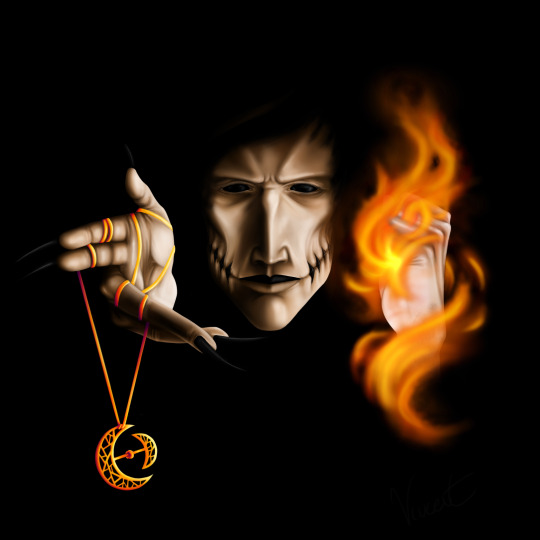
The Void-God by Vasisthae
Marëakhs Stygal [maɾi-aχs. ʃtɪ-gal] also known as Marëkhs or Sädsuleth, the Void-God. As a greater void, Mariax Stygal is the lord of secrecy, whispers, and the shadows. His role in andeamer religion is a complex one concerned with hidden motives, both good and bad as well as redemption and revolution; his sphere is often abridged to a nuanced idea of “duality”. The realm of Mariax Stygal is the Fringe Athenaeum, where you may find whatever you seek. According to lore, mortals are welcome here, free from fear of the sädthäsan inhabiting this plane—but this may come at a cost. Within his realm, one may find a confidant to the Void-God, Ronov. Ronov is said to be his lieutenant and described as a golden man with four eyes and clothed in white. The underlings of Mariax Stygal will guide any within the Athenaeum and outside this world as well—All one must do is ask.
#digital art#digital painting#worldbuilding#digital sketch#Digital Illustration#digital portrait#digital media#fantasy world#otherworld#worldbuilding lore#lovecraftian#fantasy#fantasy character#Fantasy Writing#fantasy art#dark fantasy#original writing#original character#Original Work#original art#dark aesthetic#fiction#speculative fiction#fantasy fiction#Fictional Deities#art#Character Design#artists on tumblr
0 notes
Photo

In the Hall of the Void-God
Every thïsenyär has their own hall; those are the gods if you aren't familiar with Ënokhan. Each their own place we go to seek their guidance and honor them—and yes the "rumors" are true. No, it's is not a parlor trick. If they will it, they can inhabit their effigies. Any likeness of theirs, no matter how small or big. That's how we talk to them. The Void-God is no different, but he is the quietest. His lessons are best learned through experience. Inaction is his gift. Intervention is his punishment. He rather you draw your own conclusions just as I do, so keep to your path. When you have your answer, you will know.
Religion of the Andeamer
#worldbuilding#fantasy#fantasy character#fantasy art#Fantasy Writing#dark fantasy#worldbuilding lore#black and white sketch#Digital Illustration#Illustration#digital art#digital painting#digital sketch#speculative fiction#fantasy fiction#Fictional Deities#fiction#original character#original writing#Original Work#original content#original art
0 notes
Photo
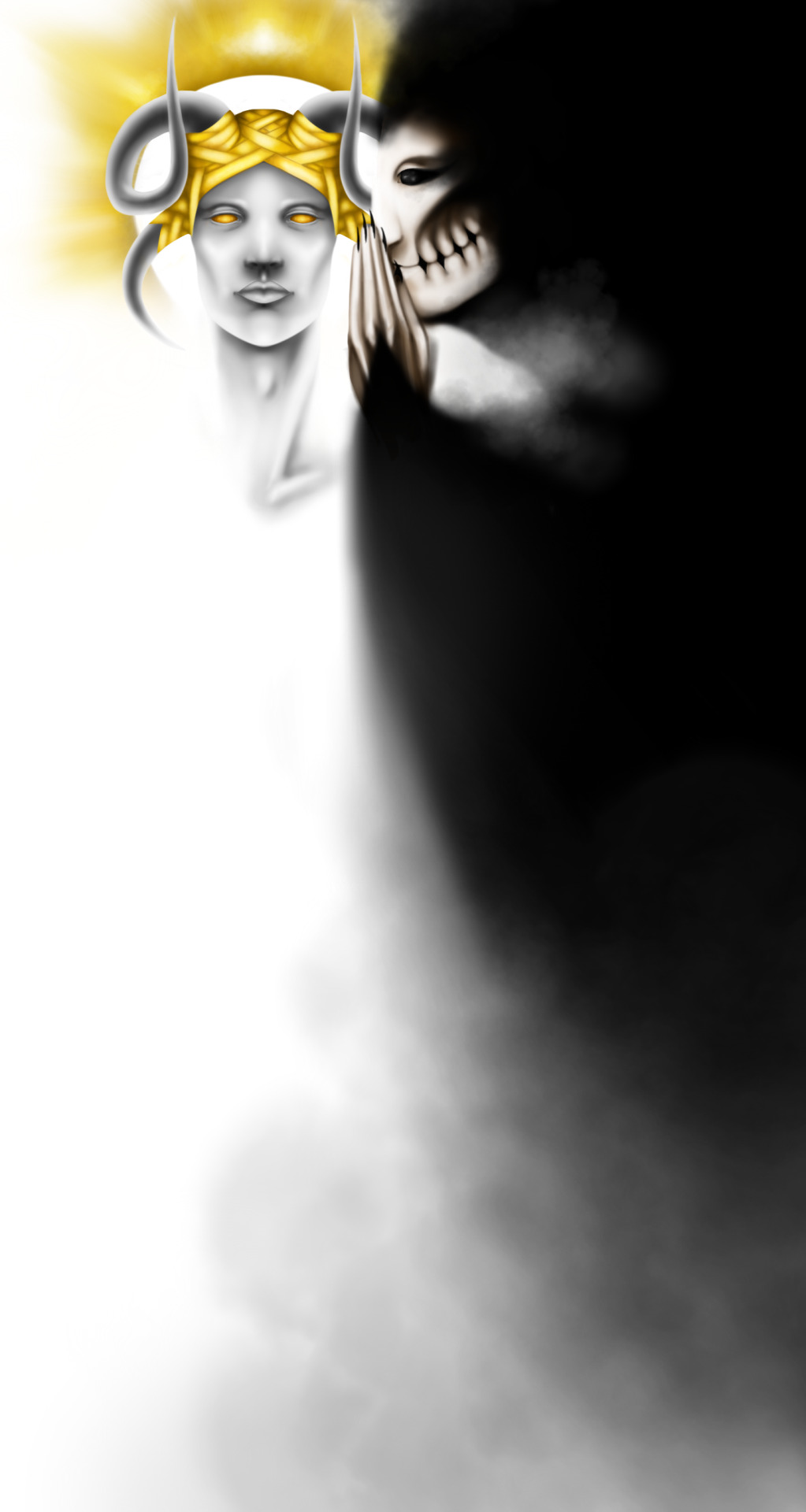
The old stories tell it was the Void-God we have to thank for our liberation from the Abyssal King. He told Mazarath what he witnessed and she began her inquisition against the Void and its King. Now we call her the Mother because she rescued us from tyranny and protects us as mothers do. She may not be our creator—that's Ënokh—but she is the reason the andeamer are as we are.
#worldbuilding#Original Work#fantasy world#otherworld#fiction#fantasy fiction#Fictional Deities#worldbuilding lore#digital art#artists on tumblr#art#fantasy character#Character Design#fantasy#fantasy art#dark fantasy#original art#original character#Illustration#digital painting#Digital Illustration#digital sketch
2 notes
·
View notes
Photo

Excerpt from The Andeamer by Robert Maddibell and Evizahn Tiragaan:
The three-headed beast is the unholy coalition of Hismäl Hamarëel, Suluth Styrr, and Surgaht Zagam. These greater voids represent corruption of the self in three dimensions. Surgat Zagam is corruption of the flesh; he is disease, sickness, taint, and defilement of the dead. Hismael Hamariel is corruption of the heart; this one concerns a complex play on relationships people have with each other whether it is romantic, platonic, or between family, this void seeks to destroy it. Suluth Styrr is corruption of the mind; this void is responsible for deterioration on the mind whether it is dementia or incurable mental illness, it is the irreversible downward spiral of the ego. To the andeamer, these testing gods are a pervasive reality in everyday life, they are known as Säthihl din’Drälothath.
#digital art#artists on tumblr#art#Character Design#fantasy character#worldbuilding#fantasy world#otherworld#otherwordly#Original Work#original art#fantasy#fantasy art#fantasy literature#dark fantasy#lovecraftian#monster#worldbuilding lore#Black and White#digital sketch#Digital Illustration#Illustration#sketchbook#Fantasy Writing#fantasy monster
2 notes
·
View notes
Photo


The thorn in the supreme goddess’ side. A stalwart wall that never gave way to her sieges. A mystery to the mortals and the divines. Her skin like the never ending storm of the Void. Her eyes the deep abyss only the great Leviathans wander. Dawned in the Twilight armor, the harbinger of doom who killed the gods. The Black Prophet.
Terrible spawn of the Void, spirit of doom, angry and wrathful mortal? The Black Prophet is an figure in Andeamer mythology who seems to be on her own side. Feared by both Void and Divine, the stories of the Dirrag tell a horrifying onslaught who could kill any divine being who drew her ire. Yet, not much is know about this enigmatic, mysterious figure. Her appearance according to the lore of the Dirrag, began closer to Year Zero, the great war. History around this time is muddled as so much upheaval has left sparse documentation. Her entrance into the history of the Andeamer was as quick as her exist, but the true fate of the Black Prophet remains unknown.
Even in her literal name she is mysterious: Vähnsäd Khïthyalventh "Dark/Black Divine-Mouth of the unknown"
Vähnsäd is thought to be more literal as black and dark are not associated with evil or hostility to the Andeamer. So she may have just appeared to be dark, whether in clothing or color. Adjacent to this is she is also described as “being dawned in the twilight armor”, this line isn’t wholly understood, but could just describe the color of her armor or something she wore.
The "khï" prefix determines she is divine herself but the "venth" addition used for those beings whose intentions and origins are vague or unknown. Depictions of her are scarce, her description in the quote above is her debut in the Dirrag. Art of her has been found in the ruins of Nir Rizaal, in an ancient temple in the heart of city, but her facade has been intentionally obscured by angry andeamer as well as thousands of years of decay.
Seldom is left of her, but the tales of the Dirrag and blasphemic curses to hurl at your enemies in hopes to bring their doom.
#digital art#artists on tumblr#art#dark fantasy#fantasy art#fantasy#fantasy character#fantasy literature#orginal concept#original character#Original Work#original content#Digital Illustration#illustration#worldbuilding#fantasy world#worldbuilding lore#otherworld#otherwordly#fantasy fiction#fiction#speculative fiction#Fictional Deities#portrait#digital painting#digital sketch#digital portrait#Female Character#portrait of woman#character concept
6 notes
·
View notes
Text
The Civilization We Call Nir Rizaal
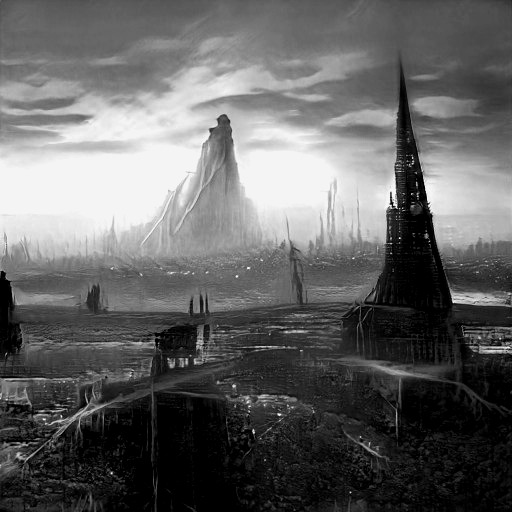
The Civilization We Call Nir Rizaal: A Quick Primer by Sälethïa Laelis,
History Department of The Valgaaren Academy; Zyendiil Maar Studies
The civilization we call Nir Rizaal has been a great fascination in the mind of the andeamer for as long as we can remember. It’s beginning and end remains our greatest mystery as a people. We know our ancestors once occupied almost the entirety of Zyendiil Maar at their height. Their great civilization lasted for millennia and then suddenly collapsed, but what happened?
#worldbuilding#worldbuilding lore#otherworld#original work#original writing#original character#speculative fiction#speculative culture#fantasy#dark fantasy#fantasy world#fantasy art#fantasy literature#fantasy writing#artists on tumblr#orginal writing#writing
1 note
·
View note
Text
The Valgaartiran

The Valgaartiran, the nation of Ënokh we are most familiar with, was formally established in 8,892 A.W., 6th Epoch in the month of Dïbe. Valgaartiran translates to “illumination of dawn”. This particular imagery for the andeamer is a symbol of hope and a promise to never return to the past responsible for the Great War. The Valgaartiran was founded with an ideal of setting itself apart from the other kingdoms, empires, and nations of Enokh, which at the time of its founding engaged in intermittent wars and much of Enokh was still suffering the consequences of the Great War even 8,000 years later.
The Valgaartiran is part 6 of 6 of The Andeamer
#worldbuilding#worldbuilding lore#fantasy#fantasy literature#fantasy world#fantasy art#dark fantasy#speculative fiction#speculative biology#speculative culture#digital art#digital painting#digital illustration#writing#original work#original writing#original content
0 notes
Text
Biology of the Andeamer

Andeamer have DNA just as humans. Their DNA, however, while having a similar pattern, is obviously different from our in terms of nucleotides and how many somatic chromosomes they posses. These differences on the miniscule level of DNA are yet to be fully discovered and so the clear physical differences will give us some idea of the microscopic inner workings of the people of Ënokh.
Biology of the Andeamer is part 5 of 6 of The Andeamer
#worldbuilding#worldbuilding lore#fantasy#fantasy literature#fantasy art#fantasy world#digital art#digital sketch#writing#fiction#speculative fiction#speculative evolution#speculative culture#original work#original content
0 notes
Text
Society of the Andeamer
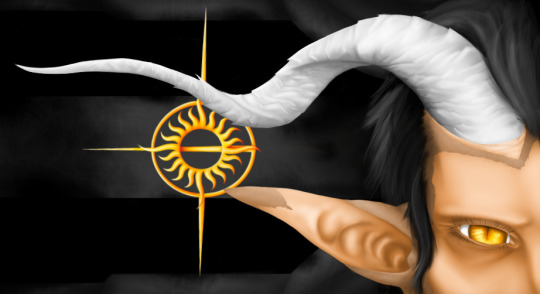
To the andeamer, family always comes first. The andeamer divide themselves into houses and these houses can be nearly as powerful and big as some city-states. The complex politics of houses and their rivalries and alliances aren’t the only forms of governance, just the oldest.
Society of the Andeamer is part 4 of 6 of The Andeamer
#worldbuilding#worldbuilding lore#speculative fiction#speculative evolution#speculative culture#digital art#fantasy#fantasy literature#fantasy world#fantasy art#digital portrait#digital painting#digital illustration#original work#original content
1 note
·
View note
Text
The Religion of the Andeamer
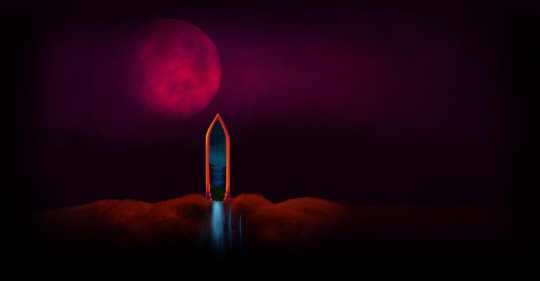
The gods and goddesses are of great importance to the andeamer. Their religion is tightly interwoven into their societies. Everyday life is entrenched is the spiritual world and not everything is as it appears to be.
The Religion of the Andeamer is part 3 of 6 of The Andeamer
#worldbuilding#worldbuilding lore#otherworld#original content#speculative fiction#speculative evolution#speculative culture#fantasy#fantasy literature#fantasy world#dark fantasy#fantasy art#digital art#digital painting#digital illustration#fictional deities#fiction#writing
0 notes
Text
Ënokhan

The language of the andeamer is called Ënokhan in its native form. Many have taken to calling it Enochian in an anglicized form, however it bears no resemblance to the biblical language of angels. All andeamer speak Ënokhan with some regional variation.
Ënokhan is part 2 of 6 of The Andeamer
#worldbuilding#worldbuilding lore#speculative fiction#speculative evolution#fantasy#fantasy literature#writing#digital art#digital painting#conlang#constructed language#fantasy art#fantasy world#original work#original content#speculative culture
1 note
·
View note
Text
The Provinces of Ënokh

Ënokhïa, the main continent, is split into five provinces defined by their geographic characteristics. Some of these regions are divided by natural geographic landmarks such as mountain and volcanic ranges. These distinctions between regions are noted to have begun sometime after the Great War.
The Provinces of Ënokh is part 1 of 6 of The Andeamer
#worldbuilding#worldbuilding lore#fantasy#fantasy literature#dark fantasy#fantasy world#fantasy art#writing#fiction#digital art#digital painting#digital illustration#speculative evolution#speculative fiction#conlang#constructed language#orginal concept
2 notes
·
View notes
Text
The Urban Legend of the Masked Man

You might not find out about the masked man by asking around your town because not many people have seen him, but I can guarantee someone has. My experience was pretty much verified by stumbling across a thread on a forum I frequent. The topic was about your favorite creepy urban legends. I was just lurking since I didn’t have anything interesting to contribute. Most posts were about the better known creatures like the infamous bunny man bridge in Virginia, the funhouse mummy, mothman… But one grabbed my interest.
This one was from a small town in northern Oregon talking about two local legends; one of the crow-man and a lesser known masked man.
The poster described both of them in detail, but the masked man was way too familiar for my liking. A porcelain mask, grinning inhumanly wide. The eyes blacked out and the wraith-like figure in all black. I responded with my experience, noting that I lived in the south, Louisiana to be exact. I had seen the masked man before, jumping from power pole to power pole. I watched it in curiosity even though I felt the urgency to get the hell out of there. I finally booked it when the thing paused and looked down at me with that grinning mask. I thought I might have seen the figure another time, this time in downtown New Orleans during Mardi Gras, but of course he blended in with the other masked people. Maybe it was whatever drugs I was on, thinking back on it.
Soon after I posted with my own experience, more people chimed in claiming to see the figure from all around the world. People even submitted a few drawings, albeit not very good. There was even one picture, it was grainy distorted and the figure was so ghost-like, its feet and legs were almost transparent. Personally I was skeptical just because of how bad the quality of the picture was.
Others claimed to see it wielding a scythe or seemingly pulling one out of nowhere. One had a more morbid experience, stating he saw the masked man actually kill someone then disappear with that person. It was very strange to see people from all the way in Australia, Europe, even South Africa claiming to see the masked man and other figures, all in black and wearing masks bearing exaggerated expressions. Several claimed to see one with the exact opposite of the masked man, having a sad face, like you’d see with drama and comedy masks. Another had a very angered expression, one was solemn, additionally one was disgust. The list could go on.
#worldbuilding#otherworld#worldbuilding lore#fantasy#fantasy literature#dark fantasy#fantasy world#digital art#digital painting#digital illustration#digital portrait#black and white#orginal writing#writing#original character#original work#fantasy art#artists on tumblr#urban legends#spooky
5 notes
·
View notes
Text
The Veherrihs

Veherrihs are people gifted with control of Mïzärn's sphere. Typically individuals have a particular skill set which defines their powers. The veherrihs as a whole are not completely and outwardly shunned by society, but there is an obvious stigma against them which varies according to their sphere. Others are more accepted because of their usefulness. However, many can be denied a place to live, work, and sometimes are even rejected by their own families. Some of these powers provoke an understandable fear such as with illusionists and void-walkers; in many instances they may be imprisoned or contained for their entire lives despite committing no crime. In more extreme cases, veherrihs are murdered.
Because of this stigma, many choose sanctuary with the temple of Mïzärn where they can openly use, study, and learn to control their powers safely. Once their powers are discovered, the veherrihs are strongly encouraged to join the temple for their own safety while some families may force the veherrihs in their lineage to join the temple. In recent decades, veherrihs have formed guilds and associations as an alternative to the temple of Mïzärn. These guilds and associations offer a family to those who have been ousted by their own blood as well as protection from the dangerous side of the stigma against the veherrihs. Some guilds allow all classifications of veherrihs while others are one type of arcane skill. Some skills are known to be profitable such as with healers or seers. Veherrihs whose skills are beneficial in battle may also join mercenary groups. The elemental variety are the most common type of veherrihs and their abilities are what often comes to the mind of the common andeamer. In the Valgaartiran, veherrihs are protected by their own laws and rights. They can be found in many occupations throughout the territory and have become valued and coveted citizens for their powers. In other more developed nations, veherrihs may find their place in a society that won't ignore them.
Classifications of Veherrihs Veherrihs are typically in tune with a particular aspect. These aspects can range from elemental manipulation to the extremely rare class of versatile veherrihs. Enchanters are veherrihs that are skilled with enchanting, but it is typically a secondary skill one can learn. Their enchanting ability revolves around their primary aspect.
Lyätath ar'Ënokh Elemental Veherrihs show aptitude is manipulation of the natural world. This is the most diverse and includes living and non-living things; liquids, gasses, fire, earth, metals, chemistry, flora, etc,... This is the most common classification and is broken down further into those who control particular things such as the veherrihs who can manipulate fire energy (heat, intensity, conjuration) or the “Gardeners” which are the veherrihs whose talent lies completely in nature; they can mature plants instantly or manipulate them into forms and even deplete them of life completely. Alchemists may be confused with illusionists, but their talent is not an illusion. Their magical talents lie in the alteration of matter.and are often considered a variant of element controlling veherrihs. They alter matter down to its molecular structure so long as they are familiar with the matter they seek to change and what they are changing it to, alchemists can change anything. They can learn the structure of anything they touch given enough time. Alchemist also tend to be in tune with patterns in general and can appear to have compulsive habitual rituals; this is believed to be caused by the nature of their gifts. The stigma against alchemist can very; typical skills are only good for altering non-organic materials such as ore or reinforcing it. The rarest alchemist can alter living things into another living material or even non-living material; these ones are feared just as illusionists and void-seers.
Välnihnäs Illusionists are a rare and very stigmatized class of veherrihs. While rare their talents for illusions, alterations, and obfuscation of reality are exceptional. They alter the perception of reality so other perceive what the illusionist wants. They manipulate the mind, thoughts, and emotion; their skillset is also known to cause damage to the nervous system especially in the brain but not as a symptom from being controlled by an illusionist. Unlike the far-seers who may be able to read minds, illusionist plant thoughts, feelings, memories, and images in another. The weak point of illusionists is that their illusion is only maintained as long as the illusionist wills.
Sëelthranerihs Healers are the second most common veherrihs, but range in healing capacity. As their name would imply their skill set revolves around health. They can detect and heal ailments which can vary by simple cuts to illnesses. The healers who are most skilled can cure ailments as severe as cancers, but these individuals are extremely rare. Some legends tell of healers resuscitating the dead, but this ability would seem to similar to the powers of some Seers who could revive deceased things. However the difference would be very appearant; the ones revived by healers were brought back before they began putrification and essentially reversed their deaths while Seers were said to be able to bring back anything, but the product was said to be "horrifying abominations wrought with the stench of death" and further dissection of these tales would imply Seers are unable to reverse the post-mortem processes so the revived are not entirely intact physically or mentally.
Sädthäs Vihngär Void-seers and void-walkers are veherrihs who are sensitive to the Void. Unusual talents include summoning and binding Voids as well as projecting themselves into the void. Exceptionally talented void-walkers and seers can open actual portals into the void and physically enter it. The only people known to have the ability to do this are the high priestesses of Mazarath. They are not prone to the corruption of the void and some are completely immune. They are rare but feared for their abilities as it allows the void to seep into reality. These veherrihs are known to be versatile rather than have their ability focus entirely on the energy of the Void. Versatile veherrihs are the rarest and sometimes unheard of. Their talents extend beyond a particular skill set to encompass many. Their existence is often doubted. As for the matter of whether one can learn to extend their magical abilities outside of their attunement is possible, but known to be extremely difficult for veherrihs.
Ërathï Seers are veherrihs with the extra-sensory capacity to communicate with the dead and perceive the hidden world of the ätherä and voids. Their sensitivity to the hidden world of the ätherä and voids allows them to communicate efficiently and effectively with these beings as well as perceive their motives or given purpose. An exceptional ability very few possess is akin to necromancy and can revive dead things for minutes or even indefinitely for those with the capacity. Accounts of this ability describes it as ranging between possession of a deceased thing such as what the voidly followers of Surgat Zagam are known to do all the way to the necromantic power described earlier. The revived are typically in a suspended state of decay and not capable of regeneration and sometimes depending on this state their mental faculties may be compromised. Seers with this rare talent are not welcomed openly in many parts of Ënokh, thus they often keep it a secret just as with other veherrihs whose talents are not socially acceptable.
Far-Seers are veherrihs with the talent for precognition, but can also witness past events regardless if they themselves were present or alive during the event. They also tend to be empaths and some extend this ability further into telepathy. Their variety of telepathy is limited to perception of others thoughts and feelings rather than the ability to put thoughts or feelings into others like with illusionists. Many are more weary of far-seers because of this, but these veherrihs are better suited to blending into society without drawing attention to themselves. One the other side of this, they are coveted for their ability and are targets for governments who wish to use them as agents or others who seek to do them harm for what they know.
#worldbuilding#worldbuilding lore#otherworld#fantasy#fantasy literature#dark fantasy#fantasy world#fantasy art#writing#original work#original content#speculative fiction#speculative culture#magicfolk#magic#fictional deities
0 notes
Photo

The thorn in the supreme goddess’ side. A stalwart wall that never gave way to her sieges. A mystery to the mortals and the divines. Her skin like the never ending storm of the Void. Her eyes the deep abyss only the great Leviathans wander. Dawned in the Twilight armor, the harbinger of doom who killed the gods. The Black Prophet.
#worldbuilding#worldbuilding lore#fantasy#dark fantasy#fantasy literature#original character#character design#art#fictional deities#otherworld#female character#fantasy art#artists on tumblr#original content#Original Work#original writing#original art#digital portrait#portrait#fantasy character#fantasy female#Digital Illustration#illustration#colored drawing#drawing
0 notes
Photo

At all times he had something to guard. Whether his charge was a councilor of the mërakh din’üsarr or the peculiar box grasped in his claws and hidden under an arm, he knew his purpose. But such instinct was expected of a Laelis. With every step greaves and pauldrons sang together, but despite the cacophony of metals and leather his thoughts fixed solely on the box. There must be someone who could disenchant it. Allow him to open the mystery or reveal its purpose.
- The Three-Headed Beast
#worldbuilding#worldbuilding lore#fantasy#original character#character design#fiction#fantasy art#dark fantasy#fantasy literature#portrait#digital portrait#digital art#digital painting#digital illustration#colored work#colored drawing#fantasy world#fantasy character
2 notes
·
View notes